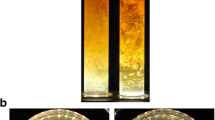Summary
A method for enumeration of viable numbers of Thiobacillus ferrooxidans using membrane filters on ferrous-iron agar is presented. Factors affecting colony production were the concentration and brand of agar, pH of the medium, and type of membrane filter. The results suggest that inhibition of T. ferrooxidans by agar is a result of the acid hydrolysis of agar, the main product of which is d-galactose. Colony development was suppressed by aged medium, by acid-hydrolysed agar and by 0.1% galactose. Sartorius and Millipore membrane filters were suitable for the experiments, whereas Oxoid MF-50 membranes virtually suppressed the production of colonies. The method was employed to follow growth of T. ferrooxidans in pH 1.3 medium. The viable cell numbers were correlated with 14CO2-fixation and ferrous iron oxidation. Generation time was 6 h 22 min with a yield of 2.2×1012 organisms/g atom Fe2+ oxidized. Growth of T. neapolitanus on thiosulphate medium was not affected by agar-type or membrane filters and yield of the organism was 1.5×1013 organisms/g molecule Na2S2O3 oxidized.
Similar content being viewed by others
References
Beck, J. V.: A ferrous-ion-oxidizing bacterium. I. Isolation and some general physiological characteristics. J. Bact. 79, 502–509 (1960).
Beck, J. V.: The role of bacteria in copper mining operations. Biotechnol. Bioeng. 9, 487–497 (1967).
Blaylock, B. A., Nason, A.: Electron transport systems of the chemoautotroph Ferrobacillus ferrooxidans. J. biol. Chem. 238, 3453–3462 (1963).
Bryner, L. C., Jameson, A. K.: Microorganisms in leaching sulfide minerals. Appl. Microbiol. 6, 281–287 (1958).
Conn, H. J. (Editor): Manual of microbiological methods, pp. 64–66. New York: McGraw Hill Inc. 1957.
Golomzik, A. I., Ivanov, V. I.: Adaptation of Thiobacillus ferrooxidans to increased hydrogen ion and iron concentrations. Mikrobiologiya 34, 465–468 (1965).
Happold, F. C., Johnstone, K. I., Rogers, H. J., Youatt, J. B.: The isolation and characteristics of an organism oxidizing thiocyanate. J. gen. Microbiol. 10, 261–266 (1954).
Kelly, D. P.: The incorporation of acetate by the chemoautotroph Thiobacillus neapolitanus strain C. Arch. Mikrobiol. 58, 99–116 (1967).
Kelly, D. P.: Fluoroacetate toxicity in Thiobacillus neapolitanus and its relevance to the problem of obligate chemoautotrophy. Arch. Mikrobiol. 61, 59–76 (1968).
Kelly, D. P.: Regulation of chemoautotrophic metabolism. I. Toxicity of phenylalanine to Thiobacilli. Arch. Mikrobiol. 69, 330–342 (1969).
Kelly, D. P.: Autotrophy: concepts of lithotrophic bacteria and their organic metabolism. Ann. Rev. Microbiol. 25, 177–210 (1971).
Kelly, D. P., Syrett, P. J.: The effect of uncoupling agents on carbon dioxide fixation by a Thiobacillus. J. gen. Microbiol. 34 307–317 (1964).
Kelly, D. P., Tuovinen, O. H.: Recommendation that the names Ferrobacillus ferrooxidans Leathen and Braley and F. sulfooxidans Kinsel be recognised as synonyms of Thiobacillus ferrooxidans Temple and Colmer. Int. J. Syst. Bact. 22, 170–172 (1972).
Lapteva, A. M., Kriuchkov, V. A., Golomzik, A. I.: Application of gel plates impregnated with the medium 9K for quantitative control and isolation of Thiobacillus ferrooxidans. Mikrobiologiya 40, 572–574 (1971).
Leathen, W. W., Kinsel, N. A., Braley, S. A.: Ferrobacillus ferrooxidans, a chemosynthetic autotrophic bacterium. J. Bact. 72, 700–704 (1956).
Leathen, W. W., McIntyre, L. D., Braley, S. A.: A medium for the study of the bacterial oxidation of ferrous iron. Science 114, 280–281 (1951).
MacDonald, D. G., Clark, R. H.: The oxidation of aqueous ferrous sulphate by Thiobacillus ferrooxidans. Canad. J. Chem. Engng. 48, 669–676 (1970).
McGoran, C. J. M., Duncan, D. W., Walden, C. C.: Growth of Thiobacillus ferrooxidans on various substrates. Canad. J. Microbiol. 15, 135–138 (1969).
Merck Index: Editor, P. G. Stecher. 8th Edit., p. 24. Rahway, N. J.: Merck & Co. Inc. 1968.
Niemelä, S. I., Tuovinen, O. H.: Acidophilic thiobacilli in the river Sirppujoki. J. gen. Microbiol. 73, 23–28 (1972).
Pramer, D.: The influence of physical and chemical factors on the preparation of silica gel media. Appl. Microbiol. 5, 392–395 (1957).
Reports on public health and medical subjects, number 71: The bacteriological examination of water supplies. London: Her Majesty's Stationary Office 1969.
Shafia, F., Wilkinson, R. F.: Growth of Ferrobacillus ferrooxidans on organic matter. J. Bact. 97, 256–260 (1969).
Short, S. A., White, D. C., Aleem, M. I. H.: Phospholipid metabolism in Ferrobacillus ferrooxidans. J. Bact. 99, 142–150 (1969).
Silver, M.: Oxidation of elemental sulfur and sulfur compounds and CO2 fixation by Ferrobacillus ferrooxidans (Thiobacillus ferrooxidans). Canad. J. Microbiol. 16, 845–849 (1970).
Tabita, R., Lundgren, D. G.: Utilization of glucose and the effect of organic compounds on the chemolithotroph Thiobacillus ferrooxidans. J. Bact. 108, 328–333 (1971).
Temple, K. L., Colmer, A. R.: The autotrophic oxidation of iron by a new bacterium Thiobacillus ferrooxidans. J. Bact. 62, 605–611 (1951).
Tuovinen, O. H.: Microbiological aspects in the leaching of uranium by Thiobacillus ferrooxidans. Atomic Energy Rev. 10, 251–258 (1972).
Tuovinen, O. H., Kelly, D. P.: Biology of Thiobacillus ferrooxidans in relation to the microbiological leaching of sulphide ores. Z. allg. Mikrobiol. 12, 311–346 (1972).
Tuovinen, O. H., Niemelä, S. I., Gyllenberg, H. G.: Effect of mineral nutrients and organic substances on the development of Thiobacillus ferrooxidans. Biotechnol. Bioeng. 13, 517–527 (1971a).
Tuovinen, O. H., Niemelä, S. I., Gyllenberg, H. G.: Toxicity of membrane filters to Thiobacillus ferrooxidans. Z. allg. Mikrobiol. 11, 627–631 (1971b).
Unz, R. F., Lundgren, D. G.: A comparative nutritional study of three chemoautotrophic bacteria: Ferrobacillus ferrooxidans, Thiobacillus ferrooxidans and Thiobacillus thiooxidans. Soil Sci. 92, 302–313 (1961).
Usami, S., Sugitani, T.: The effect of organic substances on the growth and iron oxidation activity of iron oxidizing bacteria. J. Ferment. Technol. 49, 587–591 (1971).
Yates, M. G., Nason, A.: Enhancing effect of nucleic acids and their derivates in the reduction of cytochrome c by ferrous iron. J. biol. Chem. 251, 4861–4871 (1966).
Zavarzin, G. A.: Heterotrophic contaminant of Thiobacillus ferrooxidans culture. Mikrobiologiya 41, 369–370 (1972).
Author information
Authors and Affiliations
Rights and permissions
About this article
Cite this article
Tuovinen, O.H., Kelly, D.P. Studies on the growth of Thiobacillus ferrooxidans . Archiv. Mikrobiol. 88, 285–298 (1973). https://doi.org/10.1007/BF00409941
Received:
Issue Date:
DOI: https://doi.org/10.1007/BF00409941



